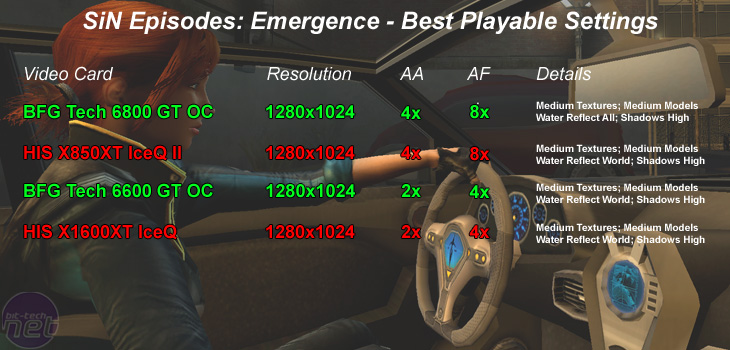Assuming you didn't eBay the Crown Jewels to fund your PC upgrade, we have also tested the game on some more modest hardware. Ritual state that the Recommended System Spec is a 2.4Ghz processor with 512MB of RAM. Unfortunately, we are unable to match the first half of that spec, as it would mean a Socket A / Socket 478 AGP motherboard.
Instead, we assembled a middle-of-the-road PCI-Express system in order to utilise our collection of PCI-Express graphics cards. We used a 19" ViewSonic LCD monitor for the test, with a native resolution of 1280x1024. We aimed to run this panel natively to avoid any drop in image quality due to scaling.
Video Cards:


As many people already know, one of the great things about the Source Engine is that it delivers great graphics without requiring a £2000 SLI gaming system to run on. Half-Life 2 was perfectly playable on hardware that struggles to play newer games like F.E.A.R. and The Elder Scrolls IV: Oblivion.
The good news is that this continues with SiN Episodes, which is even missing the recent HDR eye candy Valve added to Source - the only potential snag for gamers with older hardware. We were aiming to run the game at the native 1280x1024 resolution of our ViewSonic 19" LCD and as you can see, we succeeded.
The bad news is that GeForce 6-series cards don't support Transparency AA, so the image quality wasn't the same as for our high-end system. However, we were still able to apply 4x of vanilla AA on the GeForce 6800 GT OC and the Radeon X850XT, and 2xAA on the slower 6600 GT OC and X1600XT cards.
We began testing at Maximum Detail but it was painfully obvious that this was not an option at 1280x1024. We were forced to drop to Medium Textures and Medium Models to achieve the framerates you see here. For anyone who really wants to run at high detail, we would suggest a drop to 1024x768 and lower levels of AA. CRT gamers can get away with this quite happily but anyone with an LCD will need to check how well their panel scales away from native resolution.
At the end of the day, the best yardstick is Half-Life 2 itself - if you know you can run that at an acceptable speed, you won't have any problems playing SiN Episodes. This included our 1.6GHz Centrino notebook with ATI Mobility FireGL T2 graphics - equivalent to a 9700 Pro 128MB. It's not as pretty as our desktop systems but it still ran just fine. In this context SiN Episodes would prove a great alternative to yawnsome inflight movies.
Instead, we assembled a middle-of-the-road PCI-Express system in order to utilise our collection of PCI-Express graphics cards. We used a 19" ViewSonic LCD monitor for the test, with a native resolution of 1280x1024. We aimed to run this panel natively to avoid any drop in image quality due to scaling.
Mid-Range System Setup:
AMD Athlon 64 3700+ (operating at 2200MHz, 11x200MHz); ABIT AN8 32X (NVIDIA nForce4 SLI X16); 1 x 512MB Corsair (operating in single channel at 400MHz with 2-2-2-5-1T timings); Seagate Barracuda 7200.9 200GB 7,200RPM SATA II hard disk drive; AC '97 on-board sound; OCZ PowerStream 600W power supply unit; Windows XP Professional Service Pack 2; DirectX 9.0c; NVIDIA nForce4 SLI X16 platform drivers, version 6.82.Video Cards:
- HIS Radeon X850XT IceQ II iTurbo 256MB - operating at its default clock speeds of 520/1080MHz using Catalyst 6.4 WHQL;
- BFG Tech GeForce 6800 GT OC 256MB - operating at its default clock speeds of 370/1000MHz using Forceware 84.43, available from nZone;
- HIS Radeon X1600XT IceQ iTurbo 256MB - operating at its default clock speeds of 587/1380MHz using Catalyst 6.4 WHQL;
- BFG Tech GeForce 6600 GT OC 128MB - operating at its default clock speeds of 525/1050MHz using Forceware 84.43, available from nZone.


As many people already know, one of the great things about the Source Engine is that it delivers great graphics without requiring a £2000 SLI gaming system to run on. Half-Life 2 was perfectly playable on hardware that struggles to play newer games like F.E.A.R. and The Elder Scrolls IV: Oblivion.
The good news is that this continues with SiN Episodes, which is even missing the recent HDR eye candy Valve added to Source - the only potential snag for gamers with older hardware. We were aiming to run the game at the native 1280x1024 resolution of our ViewSonic 19" LCD and as you can see, we succeeded.
The bad news is that GeForce 6-series cards don't support Transparency AA, so the image quality wasn't the same as for our high-end system. However, we were still able to apply 4x of vanilla AA on the GeForce 6800 GT OC and the Radeon X850XT, and 2xAA on the slower 6600 GT OC and X1600XT cards.
We began testing at Maximum Detail but it was painfully obvious that this was not an option at 1280x1024. We were forced to drop to Medium Textures and Medium Models to achieve the framerates you see here. For anyone who really wants to run at high detail, we would suggest a drop to 1024x768 and lower levels of AA. CRT gamers can get away with this quite happily but anyone with an LCD will need to check how well their panel scales away from native resolution.
At the end of the day, the best yardstick is Half-Life 2 itself - if you know you can run that at an acceptable speed, you won't have any problems playing SiN Episodes. This included our 1.6GHz Centrino notebook with ATI Mobility FireGL T2 graphics - equivalent to a 9700 Pro 128MB. It's not as pretty as our desktop systems but it still ran just fine. In this context SiN Episodes would prove a great alternative to yawnsome inflight movies.

MSI MPG Velox 100R Chassis Review
October 14 2021 | 15:04










Want to comment? Please log in.